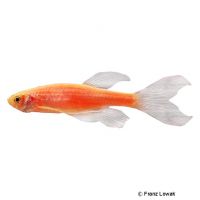Gold Long Fin Danio (Danio rerio 'Gold Long Fin')
| Gold Long Fin Danio Danio rerio 'Gold Long Fin' | |
|---|---|
| Name | Gold Long Fin Danio |
| Name Lat. | Danio rerio 'Gold Long Fin' |
| Synonym | Brachydanio rerio |
| Family | Danios |
| Family lat. | Danionidae |
| Order | Carps |
| Order lat. | Cypriniformes |
| Origin | South Asia |
| Habitat | Streams, ponds |
| Diet | Carnivore |
| pH | 6.0-8.0 |
| Behavior | Peaceful |
| Keeping | Group |
| Care Level | Easy |
| Reproduction | Egg scatterer |
| Breeding | Simple |
| Life Span | 3-5 years |
| Protection | No |
| Metric Units | |
| Size | 4-6 cm |
| Temperature | 18-25 °C |
| Hardness | 5-20 °dH |
| Aquarium | 60 cm / 54 l |
| US Units | |
| Size | 1.6"-2.4" |
| Temperature | 64-77 °F |
| Hardness | 89-356 ppm |
| Aquarium | 15 gal |
Distribution and habitat
The golden veil zebrafish is a breeding form. The zebra danio wild form is widely distributed from Pakistan to India to Myanmar. They live in slow flowing streams with dense, overhanging riparian vegetation, ponds, rice paddies and floodplains.
Maintenance
The aquarium should have a dense border planting, with hiding and retreat possibilities (roots, stones) and offer much swimming space. A dark substrate covered with some foliage (e.g. sea almond leaves), slightly shaded light (floating plants) and a weak current is ideal.
No ammonia, ammonium and nitrite should be detectable, the nitrate value should not exceed 100 mg/l. To ensure the water quality and oxygen content, a filter and heater adapted to the aquarium size is required, as well as lighting for the species-appropriate day-night rhythm of the animals.
Diet
In the wild they feed mainly on worms, insects and small crustaceans. The food supply consists of live, frozen and dry food. For a balanced diet, feed once a day with a high-quality, protein-rich dry food (flakes, granules, pellets) as well as cyclops, daphnia, mosquito larvae or artemia (live or frozen).
Only feed as much as will be eaten within a few minutes. A regular and varied diet promotes health and prevents deficiency symptoms.
Behaviour and compatibility
They are swimming and lively fish that are well suited for a community tank with other peaceful fish. At least 5, but preferably much more zebra danios should be kept together
Basically, only mutually compatible fish species with similar requirements for water conditions and water temperature should be socialized.
Sex dimorphism
The males are somewhat slimmer and more intensely colored, while the females are paler, larger and more plump.
Reproduction and breeding
They are free spawners that do not engage in brood care. The male usually swims around (drifts) the female in the early morning, which spawns (400-500 eggs) among fine-feathered plants. The larvae hatch after 24-36 hours and swim freely after a few days.
Fry must be fed several times a day with special rearing food (Artemia nauplii). In community tanks breeding is hardly possible, because the spawn is easy prey.
Important
The tank should be well covered, because they like to jump.
The well-being of the fish should be checked regularly. The temperature should be checked daily, the pH, hardness and nitrate value at least every 14 days. Regular partial water changes are recommended, even if the contaminant level has not yet reached the upper limit. Sudden changes in water quality should be avoided. Newly introduced fish must be accustomed slowly to the water in the aquarium.
Further literature can be found in your pet store.
References
Text: petdata; Image: Franz Lowak
Source: BMELV (1998): Tierschutzgutachten - Haltung von Zierfischen (Süßwasser); RIEHL & BAENSCH (2006): Aquarien Atlas Bd. 1, Mergus Verlag; ENGELMANN (2005): Zootierhaltung - Tiere in menschlicher Obhut: Fische, Verlag Harri Deutsch
- Gemäß § 21 Abs. 5 Tierschutzgesetz idgF
